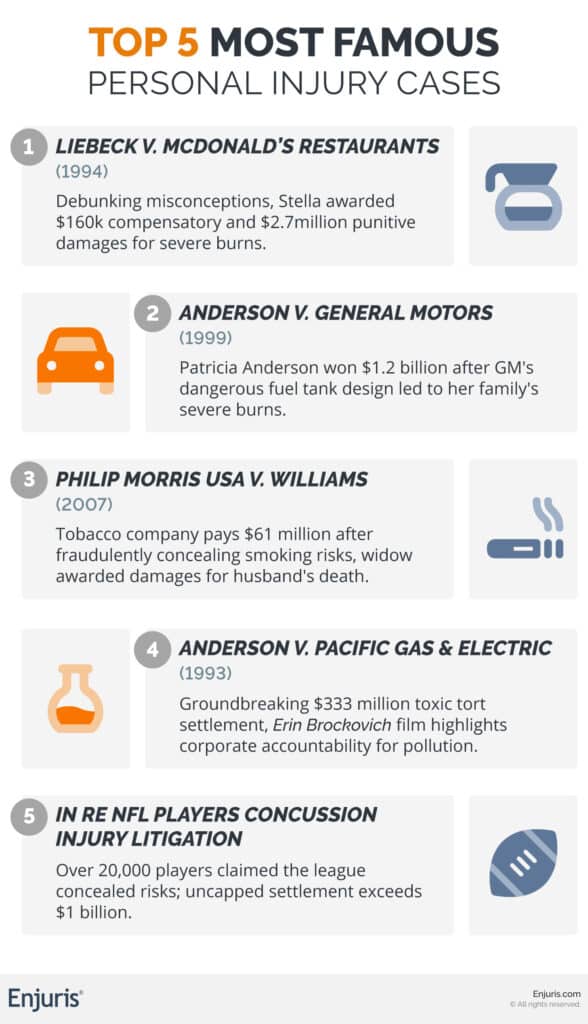[ad_1]

These five famous cases captured the world’s attention, showcasing the power of ordinary individuals fighting against the odds for justice.
If you’ve been injured in an accident and are considering filing a personal injury lawsuit, these tales of triumph might just inspire you to take action.
From an unexpected encounter with a hot cup of coffee to the most popular professional sports league being held accountable, let’s take a look at the five most famous personal injury lawsuits in the United States.

1. Liebeck v. McDonald’s Restaurants (1994)
Known as the “hot coffee case,” Liebeck v. McDonald’s Restaurants is probably the most well-known and most misunderstood personal injury case in the history of the United States.
On February 27, 1992, Stella Liebeck, 79 years old, purchased a cup of McDonald’s coffee. While sitting in the passenger seat of her grandson’s parked car, she attempted to remove the lid in order to add cream while holding the coffee cup between her knees.
The cup tipped over and the scalding hot coffee poured onto her lap.
Stella sued McDonald’s alleging that the coffee was too hot and caused significant burn injuries. The jury found McDonald’s guilty of serving coffee at an excessively high temperature and awarded Stella $160,000 in compensatory damages and a whopping $2.7 million in punitive damages.
One of the common misconceptions about the McDonald’s hot coffee lawsuit is that Stella was eager to sue McDonald’s for millions of dollars. This couldn’t be further from the truth.
Stella spent six months trying to settle with McDonald’s for $20,000 and then $15,000 to help cover her medical expenses, but McDonald’s refused. Instead, McDonald’s offered Stella $800. McDonald’s also refused Stella’s request to lower the temperature of their coffee in order to prevent future injuries to other customers.
Another common misconception is that Stella wasn’t seriously injured. This too couldn’t be further from the truth.
Stella suffered third-degree burns on more than 16 percent of her body, including her inner thighs, genitals, and buttocks where the skin was burned down to the layers of muscle and fatty tissue. As a result of her burns, Stella was hospitalized for eight days and required skin grafts and other extensive treatment. Her recovery lasted two years.
Learn the surprising true story behind the McDonald’s hot coffee case, including the fact that the plaintiff’s $2.7 million punitive damages award was reduced to $489,000.
2. Anderson v. General Motors (1999)
Patricia Anderson, along with her four children and a family friend, were involved in a horrific car accident when their 1979 Chevrolet Malibu was rear-ended by a drunk driver.
The impact caused the Malibu’s fuel tank to explode, leaving the occupants severely burned.
Patricia sued General Motors (GM), alleging that the automaker knew the fuel tank’s design was dangerous but chose not to correct it. In fact, Patrcia’s attorney presented two GM memos allegedly showing that the company believed it would cost less to settle lawsuits than to make its cars safer.
On July 9, following a 10-week trial, a California jury awarded Patricia an astonishing $4.9 billion in damages, an amount which was later reduced to $1.2 billion by the judge.
3. Philip Morris USA v. Williams (2007)
In this highly publicized case, Mayola Williams, the widow of a long-time smoker, Jesse Williams, sued the tobacco company Philip Morris, the maker of Marlboro cigarettes, for the death of her husband.
The jury found Philip Morris guilty of fraudulently concealing the risks of smoking and awarded Mayola $821,000 in compensatory damages and a massive $79.5 million in punitive damages.
Philip Morris challenged the judgment, arguing that the jury was not allowed to award punitive damages based on harm to a person who was not a party to the litigation.
The case went through several appeals, including an appeal to the United States Supreme Court. Ultimately, Philip Morris paid Mayola $61 million, as under Oregon law the state collects 60 percent of all punitive awards and places that money in a fund to compensate crime victims.
4. Anderson v. Pacific Gas & Electric (1993)
Anderson v. Pacific Gas & Electric was a groundbreaking toxic tort case that exposed the hazardous practices of the Pacific Gas & Electric Company (PG&E) in Hinkley, California.
In the lawsuit, the plaintiffs alleged that PG&E had contaminated the local groundwater with a carcinogenic chemical, leading to severe health issues among the residents.
The case was settled in 1996 for a record-breaking $333 million, making it the largest settlement in an op-out class action lawsuit at the time.
The tenacious efforts of Erin Brockovich, a paralegal who played a crucial role in uncovering evidence against PG&E, caught the attention of Hollywood. Her story was turned into a critically acclaimed film Erin Brockovich, starring Julia Roberts in the title role.
The movie not only brought the case to a wider audience but also highlighted the importance of environmental litigation in holding corporations accountable for their actions.
California personal injury attorney Tom Girardi—who was portrayed in the 2000 film Erin Brockovich—was disbarred and ordered to pay more than $2 million in restitution to his clients. Learn more about Tom Girardi’s fall from grace.
5. In re NFL Players Concussion Injury Litigation
In the 2013 class-action lawsuit, In re National Football League Players’ Concussion Injury Litigation, more than 20,000 retired NFL players took legal action against the National Football League (NFL).
The plaintiffs claimed the NFL had concealed the long-term risks of concussions and traumatic brain injuries sustained during their careers. The suit alleged that the league failed to protect players and adequately inform them about the potential dangers of repetitive head trauma, which has been linked to chronic traumatic encephalopathy (CTE) and other neurodegenerative diseases.
The case marked a turning point in the public’s understanding of the long-term consequences of head injuries in football and other contact sports.
In August 2013, the NFL reached a preliminary settlement agreement, which the U.S. District Judge Anita Brody initially rejected, citing concerns about the adequacy of the proposed $765 million fund. However, in April 2015, Judge Brody approved a revised, uncapped settlement that would provide compensation for players suffering from cognitive impairments related to head injuries. The total estimated cost of the settlement is over $1 billion, with funds allocated for medical monitoring, research, and education on concussion prevention and treatment.
What’s more, as a result of the lawsuit, the NFL has implemented significant changes in concussion protocols and invested in research and education to promote player safety.
[ad_2]



